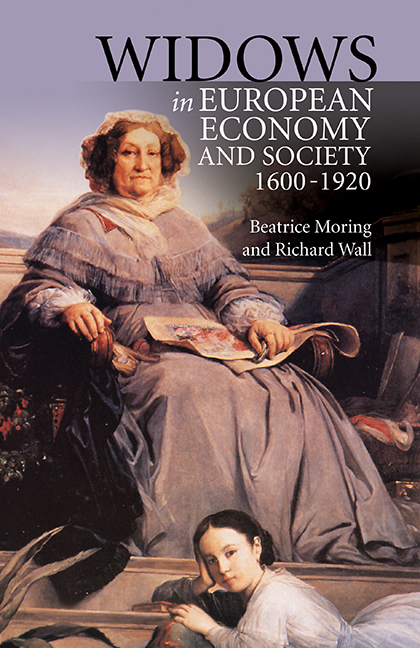Book contents
- Frontmatter
- Contents
- List of Plates
- List of Tables
- Acknowledgements
- Introduction
- 1 Widows and Poverty
- 2 Widows, Legislation and Property
- 3 Assessing the Assets of the Widow
- 4 Life Interest, Usufruct or Pension, The Mainstay of the Widow?
- 5 Urban Widows, Economy and Family
- 6 The Demography of Widowhood
- 7 Household Structure, Age, Social Status and Geography
- Conclusion
- Appendices
- Appendix 1 Abandonment
- Appendix 2 Widows and Poverty
- Appendix 3 Brief Life Histories of Poor Widows
- Appendix 4 Widows and Property
- Appendix 5 Contracts
- Appendix 6 Widows, Family and Work
- Appendix 7 Demography
- Appendix 8 Households
- Bibliography
Appendix 7 - Demography
from Appendices
Published online by Cambridge University Press: 30 August 2017
- Frontmatter
- Contents
- List of Plates
- List of Tables
- Acknowledgements
- Introduction
- 1 Widows and Poverty
- 2 Widows, Legislation and Property
- 3 Assessing the Assets of the Widow
- 4 Life Interest, Usufruct or Pension, The Mainstay of the Widow?
- 5 Urban Widows, Economy and Family
- 6 The Demography of Widowhood
- 7 Household Structure, Age, Social Status and Geography
- Conclusion
- Appendices
- Appendix 1 Abandonment
- Appendix 2 Widows and Poverty
- Appendix 3 Brief Life Histories of Poor Widows
- Appendix 4 Widows and Property
- Appendix 5 Contracts
- Appendix 6 Widows, Family and Work
- Appendix 7 Demography
- Appendix 8 Households
- Bibliography
Summary
Micro simulation application of the CAMSIM programmes
The simulation produces birth cohorts of individuals whose demographic characteristics have been predetermined. These individuals can be considered as a sample of unrelated individuals from a particular cohort in a stable population. In order, however, to compare the attributes of a cohort with empirically-based cross-sectional data, the size of successive cohorts needs to be adjusted in accordance with the growth rate in the population indicated by the reconstitutions. The correction has been made, in this instance, by applying the appropriate stable population growth rate to each age group in each cohort. Assumptions embodied in the simulation are that the mean age at first marriage of each cohort matches that indicated by the reconstitutions with the distribution of marriage ages sampled from the Coale-McNeill marriage model for that mean age at marriage but with an age range of 15–50. It has also been assumed that the marriage ages of husband and wife were correlated (r = 0.35). The mortality rates used were those indicated by life-tables for the ever-married population in the reconstitutions. No adjustments were made for any differences in mortality dependent on marital status, and the dates of death of husband and wife were assumed to be independent, the likelihood of the survivor dying neither increasing nor decreasing as a consequence of their widowed status. Other assumptions were rates of lifetime celibacy of 10 percent for men, and 12.5 percent for women, rates which remained the same over time, and a probability of remarriage of 25 percent for women and 50 percent for men at intervals indicated by the reconstitutions and subject to a maximum age at remarriage of 45.
The simplifying assumptions that it has been necessary to make to produce the simulations can certainly be challenged. There is evidence from the 1920s and 1930s of associations between the level of mortality and marital status in a number of national populations, both within and beyond Europe. For England, there is also evidence to suggest that the frequency of remarriage did change over time, as did the incidence of lifetime celibacy.
- Type
- Chapter
- Information
- Widows in European Economy and Society, 1600-1920 , pp. 278 - 280Publisher: Boydell & BrewerPrint publication year: 2017

